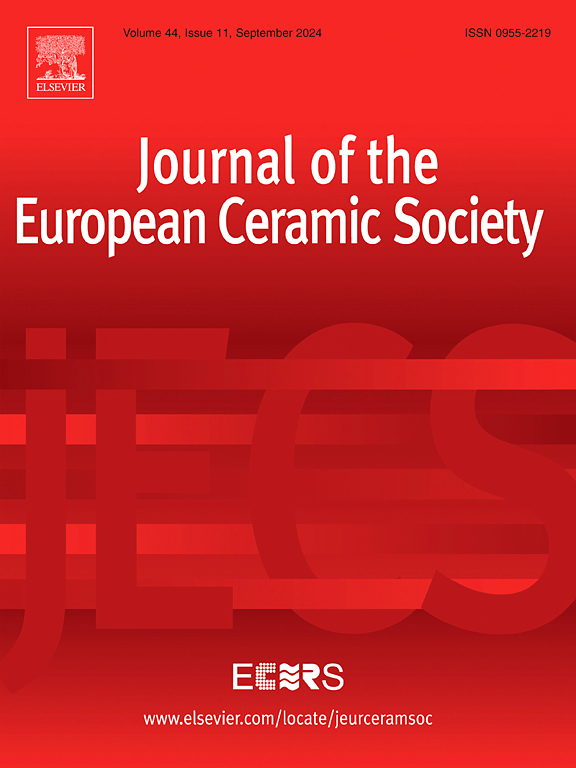直接电场和交变电场作用下钛酸锶多晶闪烧中氧和阳离子空位的变化
IF 6.2
2区 材料科学
Q1 MATERIALS SCIENCE, CERAMICS
Journal of The European Ceramic Society
Pub Date : 2025-06-07
DOI:10.1016/j.jeurceramsoc.2025.117611
引用次数: 0
摘要
在直接(DC)和交流(AC)电场强度分别为100和200 V/cm的条件下,利用在晶内和距晶界10 nm处观察到的电子能量损失近边结构,研究了钛酸锶闪烧过程中点缺陷的形成。在直流电场作用下,两个区域产生的氧空位都比无电场作用下多,但只有在200 V/cm的交流电场作用下才有相同的现象。同样,在直流电场下,两个区域都产生了锶空位,而在交流电场下,只在晶粒内产生了锶空位。在交流电场作用下,空位形成的差异可能与它们在晶界处的产生和湮灭速率有关。电场诱导空位形成机制的复杂性需要进一步阐明,但这项工作强调了考虑氧和阳离子空位在闪蒸烧结过程中加速质量扩散中的作用的重要性。本文章由计算机程序翻译,如有差异,请以英文原文为准。
The variation of oxygen and cation vacancies in strontium titanate polycrystals flash-sintered under direct and alternating electric fields
Point defect formation was investigated based on the electron energy-loss near-edge structure observed within the grains and 10 nm from the grain boundaries of strontium titanate flash-sintered under direct (DC) and alternating (AC) electric fields with strengths of 100 and 200 V/cm. More oxygen vacancies were generated in both regions under the DC field than under no field, but the same behavior was only observed under the AC field of 200 V/cm. Similarly, strontium vacancies were generated in both regions under the DC field but only within the grains under the AC field. The discrepancies in vacancy formation may be related to their generation and annihilation rates at grain boundaries under AC electric fields. The intricacies of the electric field-induced vacancy formation mechanism require further elucidation, but this work underscores the importance of considering the roles of both oxygen and cation vacancies in the accelerated mass diffusion during flash sintering.
求助全文
通过发布文献求助,成功后即可免费获取论文全文。
去求助
来源期刊

Journal of The European Ceramic Society
工程技术-材料科学:硅酸盐
CiteScore
10.70
自引率
12.30%
发文量
863
审稿时长
35 days
期刊介绍:
The Journal of the European Ceramic Society publishes the results of original research and reviews relating to ceramic materials. Papers of either an experimental or theoretical character will be welcomed on a fully international basis. The emphasis is on novel generic science concerning the relationships between processing, microstructure and properties of polycrystalline ceramics consolidated at high temperature. Papers may relate to any of the conventional categories of ceramic: structural, functional, traditional or composite. The central objective is to sustain a high standard of research quality by means of appropriate reviewing procedures.
 求助内容:
求助内容: 应助结果提醒方式:
应助结果提醒方式:


